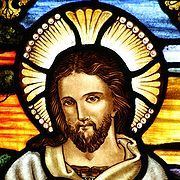- Chalcedonian Christianity
-
Chalcedonian describes churches and theologians which accept the definition given at the Council of Chalcedon (451 AD) of how the divine and human relate in the person of Jesus Christ. While most modern Christian churches are Chalcedonian, in the 5th–8th centuries AD the ascendancy of Chalcedonian Christology was not always certain. The dogmatical disputes raised during this Synod led to the Chalcedonian schism and as a matter of course to the formation of the non-Chalcedonian body of churches known as Oriental Orthodoxy. The Chalcedonian churches were the ones that remained united with Rome, Constantinople and the three Greek Orthodox patriarchates of the East (Alexandria, Antioch and Jerusalem), that under Justinian II at the council in Trullo were organised under a form of rule known as the Pentarchy.
The majority of the Armenian, Syrian, Coptic, and Ethiopian Christians rejected the Chalcedonian definition, and are now known collectively as the Oriental Orthodox churches. But, some Armenian Christians (especially in the region of Cappadocia and Trebizond inside the Byzantine Empire) did accept the decisions of the Council of Chalcedon and engaged in polemics against the Armenian Apostolic Church.[1] Churches of the Syriac tradition among the Eastern Catholic Churches are also Chalcedonian. The Georgians, as a sister church to the Armenians, originally rejected the Council of Chalcedon[citation needed], but early in the 7th century they converted to Eastern Orthodoxy and accepted this dogmat.
Contents
The Chalcedonian and the Non-Chalcedonian definition
Main articles: Chalcedonian Creed and Hypostatic unionThe Chalcedonian understanding of how the divine and human relate in Jesus of Nazareth is that the humanity and divinity are exemplified as two natures and that the one hypostasis of the Logos perfectly subsists in these two natures. The Non-Chalcedonians held the Cyrillian position of Miaphysitism: that in the one person of Jesus Christ, divinity and humanity are united in one nature, the two being united without separation, without confusion, and without alteration. This led many members of the two churches to condemn each other: the Chalcedonians' condemning the Non-Chalcedonians as Eutychian Monophysites, and the Non-Chalcedonians' condemning the Chalcedonians as Nestorians.[2]
Dissent from the Chalcedonian view
In accepting the trinitarian views supported by the concept of hypostatic union, those present at the Council of Chalcedon rejected the views of the Arians, modalists, and Ebionites as heresies (these views had also been rejected at the First Council of Nicaea in AD 325).
Those present at the Council also rejected the christological views of the Nestorians, Eutychians, and the monophysites. Later interpreters of the Council held that Chalcedonian Christology also rejected monothelitism and monergism. Those who did not accept the Chalcedonian christology were collectively known as non-Chalcedonian. Those who held to the non-Chalcedonian christologies called the doctrine of Chalcedon dyophysitism.
References and notes
- ^ Hacikyan, Agop Jack; Basmajian, Gabriel; Franchuk, Edward S, The Heritage of Armenian Literature: From the Sixth to the Eighteenth Century
- ^ , British Orthodox, http://www.britishorthodox.org/113e.php.
See also
Categories:- Christology
- God in Christianity
- Christian terms
- Chalcedonianism
Wikimedia Foundation. 2010.

